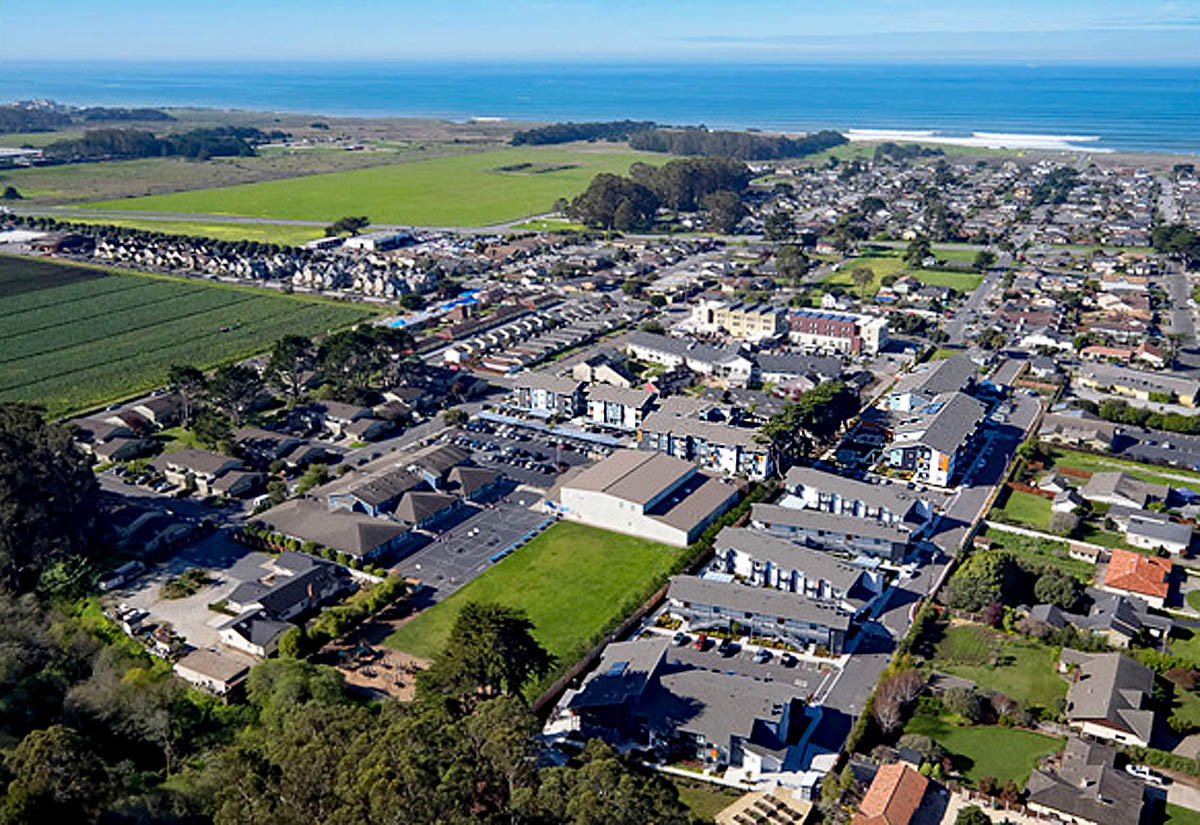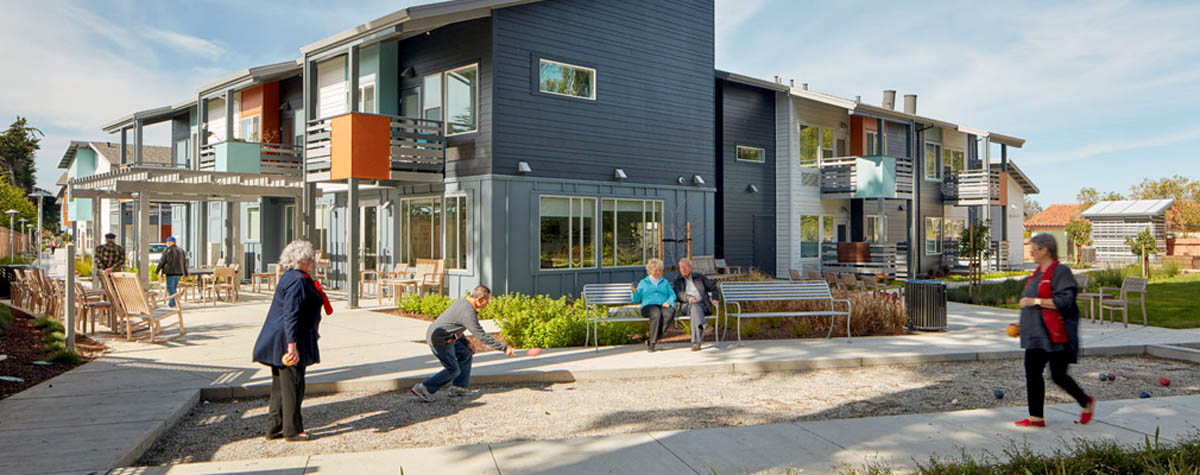Half Moon Bay, California, a small city located 30 miles south of San Francisco along the Pacific coast, has adopted policies to address the affordable housing and social service needs of its growing population of senior residents. The city is in one of the most expensive housing markets in the country, and its housing element projects that the need for affordable senior housing will grow as the city’s population increases. Senior residents also need health care and social services so that they can age in place as an alternative to institutionalized care in nursing homes. In recent years, a collaboration among San Mateo County, the city of Half Moon Bay, and local service providers has resulted in the Half Moon Bay Senior Campus, which provides housing, services, and amenities on a 10-acre site.

The campus, derived from a 2009 plan, consists of 264 units of affordable rental housing in 3 separate developments that help senior residents age in place. In addition to offering social services through its onsite adult day health center and senior center, the campus encourages aging in place and active living through a network of pedestrian pathways as well as adjacent bus stops that provide access to the nearby downtown. One of the 3 housing developments on the campus is Half Moon Village, 160 units of affordable rental housing and services for low-income seniors.
Half Moon Village
Half Moon Village provides housing for seniors aged 62 and older who earn between 30 and 60 percent of the area median income. Of the 160 units, 149 are one-bedroom apartments and 11 are two-bedroom apartments. All the apartments, which are arranged in seven 2- and 3-story buildings within a network of community gardens, are designed to be accessible for users of wheelchairs, with grab bars in all showers and bathrooms. The project also incorporates sustainable elements such as high-efficiency heating and cooling systems, solar-thermal water heating, low-flow plumbing, and ENERGY STAR® appliances. Each unit has south-facing windows to maximize exposure to light and air as well as a balcony or patio so residents have a private space to enjoy the outdoors.
Half Moon Village’s building placement and site design create welcoming outdoor spaces that keep residents from feeling confined to their units, according to Abby Potluri, director of housing development for MidPen Housing, the project’s developer. The architects eliminated a preexisting street on the site to create safe walking conditions for the residents. Pathways dotted with outdoor exercise stations ensure that residents from all three housing developments at Half Moon Bay Senior Campus can easily access its amenities. Outdoor common spaces at Half Moon Village — including a bocce ball court, community gardens, outdoor patios, and public sculptures — offer residents opportunities for social contact, as do the interior community spaces: a fitness room, a computer lounge, and common rooms for activities such as arts and crafts.

The campus occupies a site near downtown Half Moon Bay that combined several underused parcels. Two affordable housing developments were located there, including an aging 60-unit public housing project that city and county officials hoped to replace. The campus plan called for redeveloping the housing authority property and adding 140 affordable senior units on the site. With the addition of facilities for two nonprofit organizations to the campus, the plan for new buildings and more intensive use of the site gained the support of local elected officials. The developers built Half Moon Village in two stages to accommodate existing residents without having to temporarily relocate them offsite.
Financing of Half Moon Village
Low-income housing tax credits accounted for more than half of Half Moon Village’s $57.2 million development cost (table 1). According to Potluri, a land swap among the county, city, and nonprofit Peninsula Open Space Trust made the development possible: a 99-year lease from the county housing authority relieved the developer of $8.4 million in land costs. In addition, the housing authority provides project-based vouchers that contribute to Half Moon Village’s affordability.
Table 1: Financing for Half Moon Village
| Ground lease value (donated) | $8,370,000 |
| Conventional permanent loan | 9,059,000 |
| Housing Authority of the County of San Mateo | 2,102,000 |
| County HOME Investment Partnerships Program/Community Development Block Grant | 2,100,000 |
| Deferred developer fee | 350,000 |
| Low-income housing tax credits | 35,261,000 |
| Total | $57,242,000 |
Services for Aging in Place
Housing affordability is a crucial factor for aging in place and improving residents’ well-being. Affordability is a foundation that can enhance the effectiveness of the numerous support services available to residents of the Half Moon Bay Senior Campus. MidPen Housing supplies two full-time managers who arrange for staff to help residents needing assistance with daily activities. The managers also schedule nursing students to conduct onsite healthcare screenings. In addition, residents can participate in programs at the adjacent adult day health center and senior center. The adult day health center offers an extensive range of health and supportive services, including physical therapy and clinical social workers, and the senior center provides group activities, a nutrition program, and other services.
In addition to the reduced healthcare costs achieved through these services, a demonstration program taking place at Half Moon Village might generate additional savings. The Community Care Settings Pilot, a joint effort of California’s MediConnect Plan and the Health Plan of San Mateo County, is helping 12 households who are dually eligible for Medicare and Medi-Cal and at risk of entering nursing homes. The pilot provides intensively coordinated social services to help these seniors extend independent living and avoid entering more expensive nursing homes. For these residents, staff from MidPen Housing collaborate with the county’s Health Plan and their service providers to administer case management, referrals to medical treatment, and other services that augment the services of the county’s Health Plan.
Award-Winning Design
Half Moon Village earned a 2017–2018 Global Award for Excellence from the Urban Land Institute for its integration of housing, common spaces, and services intended to encourage resident interaction and an active lifestyle for seniors. One resident describes the integration of housing and services as a “comfort to know that as I age and need more supportive services, they’re just steps away.” Many residents use the outdoor exercise stations on the campus and participate in the lunch program at the nearby senior center. Residents use the bus stops close to the site for regular transportation to the nearby downtown. Also promising is the 25 percent reduction in hospitalization costs and 97 percent reduction in skilled nursing costs over 18 months for the participants in the Community Care Settings Pilot. That program’s success has inspired MidPen Housing to replicate the service coordination model for eligible residents at two other properties that it manages in San Mateo County.

